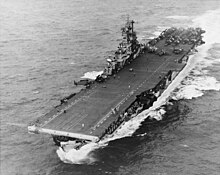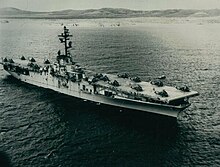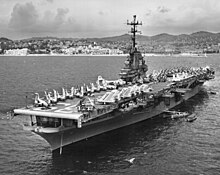United States Navy Service Life Extension Program
The Service Life Extension Program ( SLEP ) is a procedure by which the warships of the US Navy to extend a general overhaul of their period of use. As a rule, after about 15 to 20 years of service, the ships are subjected to a so-called midlife conversion (in German: "Umbau in der Lebensmitte" ), which means that the age of the ships when they are transferred to reserve status is about 30 to 40 years is configured. But it may also be necessary to modernize it several times at shorter intervals in order to adapt the units concerned to the operational requirements.
This article is intended to summarize these programs.
Aircraft carrier
In the case of US Navy aircraft carriers, the Essex-class and Midway-class carriers went through the most intense and complex SLEPs.
Essex class
At the end of the Second World War , many porters joined the reserve fleet. Many of these aircraft carriers were reactivated during the Korean War , but few were actually used. Before these carriers could return to active service, they went through one of the following programs, namely SCB-27A or -27C and later possibly also SCB-125 and SCB-125A. The five conversion phases are now described below.
First, however, a table of the conversion phases follows:
| Conversion phase | Period |
|---|---|
| SCB-27A | 1948-1953 |
| SCB-27C | 1951-1956 |
| SCB-125 | 1954-1957 |
| SCB-125A | 1957-1959 |
| SCB-144 | 1960s 1 |
1 FRAM-II modernization of aircraft carriers converted to SCB-27A and designated as CVS
SCB-27A
The US Navy's first modernization program for its aircraft carriers was SCB-27A. Eight girders were rebuilt in the period from 1948 to 1953 . These were the Essex (CV-9) , Yorktown (CV-10) , Hornet (CV-12) , Randolph (CV-15) , Wasp (CV-18) , Bennington (CV-20) , Kearsarge (CV-33 ) and Lake Champlain (CV-39) .
After the SCB-27A was completed, the Oriskany (CV-34) was completed. She received all extensions according to SCB-27A during her completion.
The main features of these conversions were:
- Expansion of the hull width in waterline to 30.8 m (101 ft)
- Replacement of the hydraulic catapults of type H-4-1 by catapults of type H-8 . These catapults could launch aircraft with a weight of 20 tons.
- Reinforcement of the landing area
- Removal of all 12.7 cm twin towers from the aircraft deck
- Installation of new elevators
- Assembly of jet deflectors for jets
- Installation of an escalator from the new standby rooms (below deck) to the flight deck
- Installation of a new smaller and shortened island
- Removal of the armor in the waterline
- New ammunition and bomb elevators
- Increase in aircraft fuel capacity
- Subdivision of the hangar with fireproof roller doors
- Installation of stronger aircraft cranes
SCB-27C
During the modernization phase of SCB-27C there were two groups of modifications. The conversions were carried out between 1951 and 1956.
- The first subgroup included carriers Intrepid (CV-11) , Ticonderoga (CV-14), and Hancock (CV-19) . In the period from 1951 to 1954, in addition to the measures taken by SCB-27A, the following extended modifications were made:
- Extension of the hull width in waterline to 31.4 m (103 ft)
- Installation of 2 steam catapults of the type C-11
- Reinforcement of the flight deck
- New starboard side elevator that was also foldable
- Installation of a stronger brake cable system
- In the second subgroup were the Lexington (CV-16) , Bon Homme Richard (CV-31) and Shangri-La (CV-38) carriers .
- These aircraft carriers were rebuilt after the expanded SCB-27C. The modernization of SCB-125 was also carried out during this conversion phase. All these conversions were carried out on these three ships while they were in the shipyard, from 1951 to 1955.
SCB-125
This modernization phase affected three groups of aircraft carriers:
- Lexington (CV-16) , Bon Homme Richard (CV-31) and Shangri-La (CV-38) , on which SCB-27C and SCB-125 were carried out while in dock
- Intrepid (CV-11) , Ticonderoga (CV-14) and Hancock (CV-19) , where SCB-125 was carried out during an additional docking time after which it had previously passed through SCB-27C. The period of this measure was between 1955 and 1957.
- Essex (CV-9) , Yorktown (CV-10) , Hornet (CV-12) , Randolph (CV-15) , Wasp (CV-18) , Bennington (CV-20) and the Kearsarge (CV-33) , which have already been modernized according to SCB-27A. These ships had to undergo this conversion phase between 1954 and 1957.
The following changes were made to the ships:
- Installation of a sloping deck
- Installation of the closed bow , called hurricane bow in English
- Installation of an improved brake cable system
- Reduction of the number of brake cables by half
- Enlargement of the front midship elevator (only on SCB-27C ships)
- Reinforcement of the emergency barrier
- The flight control station ( Primary Flight Control , PFC for short) was attached to the aft edge, two decks high
- Improved protection of the island
- Third folding elevator to starboard
SCB-125A
Only Oriskany (CV-34) received this measure . During this renovation phase the following was carried out:
- Reloading of the flight deck
- Installation of C11 steam catapults
- Installation of the closed bow
- Installation of a sloping deck
- Installation of a stronger brake cable system than on the other SCB-27C units
- All SCB-125 improvements
SCB-144
This conversion phase was given to the ships converted to SCB-27A and classified as CVS. These were Essex (CV-9) , Yorktown (CV-10) , Hornet (CV-12) , Randolph (CV-15) , Wasp (CV-18) , Bennington (CV-20) and the Kearsarge (CV-33 ) . Here additional equipment was built into them so that they could better carry out their task as submarine carriers. The following equipment was also installed:
- Installation of a bow sonar dome with SQS-23 sonar
- Installation of a steved hole and a bow crane
- Modernized operations center
Table modernization Essex class
| No. | Surname | SCB-27A | SCB-27C | SCB-125 | SCB-125A | Dockyard time (s) |
|---|---|---|---|---|---|---|
| Beginning - end | Beginning - end | Beginning - end | Beginning - end | in months | ||
| 9 | Essex | September 1, 1948–1. February 1951 | March 1, 1955–1. March 1956 | 20th | ||
| 10 | Yorktown | February 15, 1951–2. February 1953 | July 31, 1954–15. October 1955 | 16 | ||
| 11 | Intrepid | September 24, 1951-18. June 1954 | August 24, 1955–2. May 1957 | 20th | ||
| 12 | Hornet | June 14, 1951–1. October 1953 | January 24, 1956–15. August 1956 | 15th | ||
| 14th | Ticonderoga | July 17, 1951–1. October 1954 | November 7, 1955–1. April 1957 | 15th | ||
| 15th | Randolph | June 22, 1951–1. July 1953 | March 1, 1955-12. February 1956 | 17th | ||
| 16 | Lexington 2 | July 21, 1952–1. September 1955 | July 21, 1952–1. September 1955 | 19th | ||
| 18th | Wasp | September 1, 1948-28. September 1951 | July 31, 1954–1. December 1955 | 20th | ||
| 19th | Hancock | July 17, 1951–1. March 1954 | August 24, 1954–15. November 1956 | 15th | ||
| 20th | Bennington | October 26, 1950–30. November 1952 | July 31, 1954–15. April 1955 | 20th | ||
| 21st | Boxer (as LPH-4 ) 1 | 19th | ||||
| 31 | Bon Homme Richard 2 | July 21, 1952–1. November 1955 | July 21, 1952–1. November 1955 | 21st | ||
| 33 | Kearsarge | January 27, 1950–1. March 1952 | January 27, 1956-31. January 1957 | 24 | ||
| 34 | Oriskany | Completed according to SCB-27A | September 8, 1957-29. May 1959 | 26th | ||
| 36 | Antietam | sloping deck only | September 8, 1952-19. December 1954 | 26th | ||
| 37 | Princeton (as LPH-5 ) 1 | 26th | ||||
| 38 | Shangri-La 2 | July 17, 1951–1. February 1955 | July 17, 1951–1. February 1955 | 20th | ||
| 39 | Lake Champlain | August 18, 1950-19. September 1952 | 27 | |||
| 45 | Valley Forge (as LPH-8 ) 1 | 26th |
- 1 this Essex-class - aircraft carriers were the same as LPHS rebuilt
- 2 this Essex-class - aircraft carrier underwent a second subset of SCB-27C also equal to the modernization of SCB-125
Interesting features of the Essex modernization
- Antietam was the first US Navy aircraft carrier to have a sloping deck
- Oriskany was the firstaircraft carrier completedaccording to SCB-27A
- Hancock was the firstaircraft carrier completedafter SCB-27C but without a sloping landing deck
- Shangri-La was the first aircraft carrier to operate with a sloping deck
- Lake Champlain was the only SCB-27A aircraft carrier not to SCB-125 was rebuilt
Pictures upgrading Essex class
This table of images contains an aircraft carrier for the corresponding modernization phases from the overview table above. These pictures show the aircraft carriers in their original state and after their respective modernization phases.
| Original state | After 1st modernization | After 2nd modernization |
|---|---|---|
Midway class
The three aircraft carriers of the Midway class went through one each tailored to the wearer SLEP program.
The following table gives an overview of the conversion phases. Then each of the three conversion phases is described in more detail.
SCB-110
The following renovations were carried out for Franklin D. Roosevelt and Midway :
- Removal of the armored belt in the waterline
- Installation of a sloping deck that was offset by 8 ° to the ship's axis
- Installation of an Atlantic bug
- Modernization of the island
- Installation of C-11 steam catapults
- Modernization of the ship electronics
- Only the Franklin D. Roosevelt received a conical mast
- Reduction of artillery pieces
- Installation of a Fresnel land mirror
- Reinforcement of the brake cable system
- Reduction of the brake cables
- Aft elevator replaced with starboard elevator
- There was another external elevator at the end of the sloping deck
- Enlargement of the internal elevator
- Enlargement of the bunker capacity for aviation fuel

Midway before modernization
|

Midway after modernization SCB-110
|

Franklin D. Roosevelt facing modernization
|

Franklin D. Roosevelt after modernizing SCB-110
|
SCB-110A
The conversion of the Coral Sea basically included all measures of SCB-110. Nevertheless, the conversion was more extensive, so that the Coral Sea was different from her sister ships. The following changes have been made to SCB-110:
- Installation of a longer sloping deck
- Installation of a port elevator very far aft
- Removal of the inner elevator in the foredeck
- Installation of another external elevator to starboard but in front of the island
- Installation of a conical mast
- Installation of an additional C-11 steam catapult on the sloping deck
- Installation of a stronger brake cable system than on the sister ships
- Reduction of artillery pieces

Coral Sea before modernization
|

Coral Sea after modernization SCB-110A
|
SCB-101.66
The following modifications were carried out on the Midway during this modernization:
- Extension of the flight deck by approx. 1/3
- Installation of the C-13 Mod. 0 steam catapults
- Installation of new elevators with a lifting capacity of 50 t
- Installation of a reinforced brake cable system
- Modernization of the air conditioning
- Installation of an improved inertial navigation system
These conversions put the Midway in a position to provide service until the 1990s. With these measures, however, it also caught up with the new technological possibilities of the Forrestal class and was thus able to keep pace with aircraft technology of the 1970s.
The disadvantage of this conversion was the high price. This is also to be regarded as the reason why the Franklin D. Roosevelt did not receive SCB-101.66. She got a cheaper conversion. During this conversion, the inner elevator was removed and an elevator with a lifting capacity of 38 t was installed on the starboard side in front of the island.

Midway after SCB-101.66 modernization
|

Franklin D. Roosevelt after inexpensive SCB-101.66 modernization
|
literature
- Stefan Terzibaschitsch : Aircraft carrier of the US Navy - Flottenflugzeugträger / Escort aircraft carrier , Bernard & Graefe Verlag, Bonn 1999, 3rd edition, pp. 151–155 and pp. 222–223, ISBN 3-7637-6200-0
Web links / sources
- Photographic History of the US Navy (English)
- Naval Historical Center of the US Navy (English)












